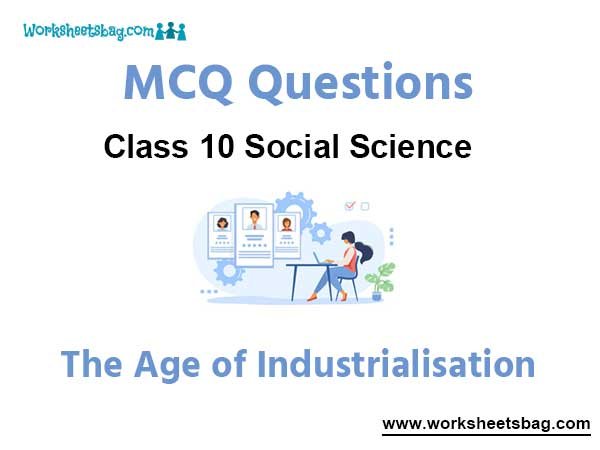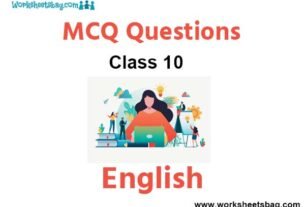Please refer to The Age of Industrialisation MCQ Questions Class 10 Social Science below. These MCQ questions for Class 10 Social Science with answers have been designed as per the latest NCERT, CBSE books, and syllabus issued for the current academic year. These objective questions for The Age of Industrialisation will help you to prepare for the exams and get more marks.
The Age of Industrialisation MCQ Questions Class 10 Social Science
Please see solved MCQ Questions for The Age of Industrialisation in Class 10 Social Science. All questions and answers have been prepared by expert faculty of standard 10 based on the latest examination guidelines.
MCQ Questions Class 10 Social Science The Age of Industrialisation
Question. The painting titled as ëHouseless and Hungryí was painted by
(a) Samuel Luke Fildes.
(b) William Bell Scott.
(c) M. Jackson.
(d) C. E Turner.
Answer
A
Question. The demand for Indian cloths could never reduce . This was said in 1772 by
(a) Henry Patullo.
(b) Warren Hastings.
(c) Lord Cornwallis.
(d) Adam Smith.
Answer
A
Question. Which of the following two problems were faced by cotton weavers in India?
(a) Short supply and decline in demand
(b) Decline in production and rise in cost
(c) Export market collapsed and local market shrank
(d) Company officials treatment and governments apathy
Answer
C
Question. Proto-industrialisation refers to
(a) modern period.
(b) period of industrialisation.
(c) post industrialisation.
(d) pre industrialisation.
Answer
D
Question. Which one is an appropriate answer that shows how factory differed from proto-industrialised scen
(a) Production increased
(b) Careful supervision, watch over quality increased in mill
(c) Workers gathered at one place
(d) Trade unions formed
Answer
B
Question. Consider the following statements and choose the correct answer from the codes given below :
I. In Victorian Britain there was no shortage of human labour.
II. Gas works, breweries needed extra workers during the summer.
III. Ship building industry needed workers during the winter.
IV. Industrialists usually preferred hand labour seasonally.
(a) I, III and IV are correct.
(b) II and IV are correct.
(c) III and IV are correct.
(d) All are correct.
Answer
A
Question. The weavers of cotton textile faced problems due to the beginning of
(a) French Revolution.
(b) Glorious Revolution.
(c) American Civil War.
(d) Russian Revolution.
Answer
C
Question. Which of the following industrial towns is located on the Chhotanagpur Plateau ?
(a) Chennai
(b) Ranchi
(c) Srinagar
(d) Sundernagar
Answer
B
Question. In 1760s and 1770s, company servants complained about
(a) high-handed treatment.
(b) competition.
(c) Indian rulers.
(d) supply and high prices.
Answer
B
Question. The first Jute Mill in Calcutta was founded by
(a) Dwarkanath Tagore
(b) Dinshaw Petit
(c) Seth Hukum Chand
(d) G.D. Birla
Answer
C
Question. Dinshaw Petit and Jamsetjee Nusserwanjee Tata who were two important industrialists in India built huge industrial empires in
(a) Bengal
(b) Bombay
(c) Kanpur
(d) Madras
Answer
B
Question. Which one of the following is the reason due to which company found it difficult to ensure goods supply to Europe in eighteenth century?
(a) The clothes or goods were costly.
(b) They were in short supply.
(c) Company faced stiff competition from others in markets.
(d) Company official were not efficient.
Answer
C
Question. Which one of the following is the reason because of which upper classes in Victorian Britain preferred things produced by hand?
(a) Hand made products were very cheap.
(b) Machine made goods were costly.
(c) Handmade products came to symbolise refinement and class.
(d) The use of such articles meant social-status.
Answer
C
Question. The most important function of the Jobber was
(a) controlling the life of the workers
(b) ensuring jobs to workers
(c) dismissing the workers
(d) exploiting the workers
Answer
B
Question. Match the following and choose the answer from the codes given below:
| Column I (Dates) | Column II (Events) |
| (a) 1850 | (i) Factory production began |
| (b) 1860 | (ii) EIC control over production increased |
| (c) 1870 | (iii) Export market collapsed |
| (d) 1880 | (iv) Cotton supplies cut off from US |
(a) A-(i), B-(ii), C-(iii), D-(iv)
(b) A-(ii), B-(iv), C-(iii), D-(i)
(c) A-(iv), B-(iii), C-(i), D-(ii)
(d) A-(ii), B-(i), C-(iii), D-(iv)
Answer
B
Question. In North India, the Elgin Mill was started in Kanpur in
(a) 1860s
(b) 1870s
(c) 1880s
(d) 1890s
Answer
A
Question. The people of Koshti community were skilled
(a) cobblers.
(b) weavers.
(c) ironsmiths.
(d) carpenters.
Answer
C
Question. By 1873, Britain was exporting iron and steel worth about
(a) £77 million.
(b) £ 75 million.
(c) £ 76 million.
(d) £74 million .
Answer
A
Question. The gross value of trade that had passed through the port of Surat during 1740s was
(a) Rs. 10 million.
(b) Rs. 7 million.
(c) Rs. 5 million.
(d) Rs. 3 million.
Answer
D
Question. The Industrial revolution set in because of-
(a) The changes in the technique and organisation of production.
(b) The revolution in agriculture
(c) The developments in maritime activities
(d) The acquisition of colonies.
Answer
A
Question. The East India Company consolidated its position in India after
(a) 1740s.
(b) 1750s.
(c) 1760s.
(d) 1770s.
Answer
C
Question. J. N. Tata established the first Iron and steel works in India in
(a) 1910.
(b) 1911.
(c) 1912.
(d) 1913.
Answer
C
Question. Koshti community lived in the
(a) Central provinces.
(b) Bengal province.
(c) Bombay province.
(d) United province.
Answer
A
Question. How proto-industrialised economy did not differed from the factory system?
(a) It was controlled by merchants
(b) The number of workers were in few numbers
(c) The producers were working within their family, not in factories
(d) Merchants controlled the entire-production
Answer
B
Question. James Watt, Newcomen and Mathew Boulton were associated with which one of the following technological innovations?
(a) agriculture
(b) cotton mill
(c) iron and steel
(d) steam-Engine.
Answer
D
Question. British were able to claim monopoly after establishing
(a) political power.
(b) factory.
(c) East India Company.
(d) Judiciary.
Answer
A
Question. Who discovered the spinning jenny ?
(a) John Ke
(b) T.E. Nicholson
(c) Raphael Samuel
(d) James Hargreaves
Answer
D
Question. Monopoly right for trading in specific products was given to Guilds by
(a) Church.
(b) Rulers.
(c) Trade unions.
(d) Sarthavaha.
Answer
B
Question. By 1850, the share of the total imported cotton piece goods in India was
(a) 32%.
(b) 31%.
(c) 30%.
(d) 29%.
Answer
B
Question. The beginning of Industrial revolution in western countries started in –
(a) America
(b) Russia
(c) France
(d) England
Answer
D
Question. The Movement launched by nationalists to boycott foreign cloth was the
(a) Swadeshi Movement.
(b) Ahmedabad Mill Satyagraha.
(c) Non Co-operation Movement.
(d) Civil Disobedience Movement.
Answer
A
Question. The industry in which the Spinning Jenny introduced first was
(a) Cotton industry
(b) Jute industry
(c) Woollen industry
(d) Paper industry
Answer
C
Question. The first symbol of the new era was
(a) cotton.
(b) silk.
(c) iron.
(d) steel.
Answer
A
Question. The Elgin Mill was established in
(a) Bombay.
(b) Bengal.
(c) Madras.
(d) Kanpur.
Answer
D
Question. Six joint stock companies were set during1830s and 1840s by an Indian entrepreneur called
(a) Jamsetjee Jeejeebhoy.
(b) Dwarkanath Tagore.
(c) Jamsetjee Tata.
(d) Seth Hukumchand.
Answer
B
FILL IN THE BLANKS
Question. ___________ created the cotton mill.
Answer
Richard Arkwright
Question. James Watt improved the steam engines produced by ___________.
Answer
Newcomen
Question. The process in which fibres, such as cotton or wool, are prepared prior to spinning is known as ___________.
Answer
Carding
Question. The era, when large scale industrial production was taking place but not with the help of factories is termed as ___________ .
Answer
proto-industrialisation
Question. The new industries could not easily displace ___________ industries.
Answer
traditional
TRUE / FALSE
Question. Armenian and Persion merchants took the goods from Punjab to Afghanistan, eastern and central Asia.
Answer
True
Question. Gas works and breweries were especially busy through the warm month.
Answer
False
Question. The fear of unemployment made workers hostile to the introduction of new technology.
Answer
True
Question. The company appointed paid servants called the gomastha to supervise weavers.
Answer
True
Question. If you had a relative or a friend is a factory, you were less likely to get a job.
Answer
False



